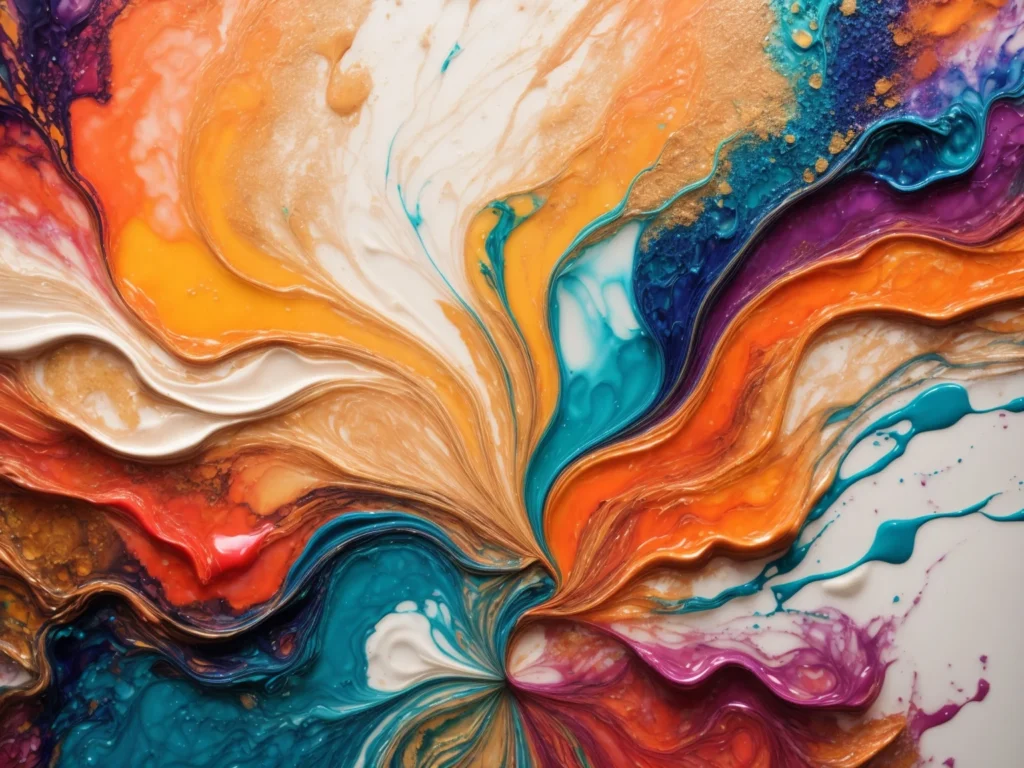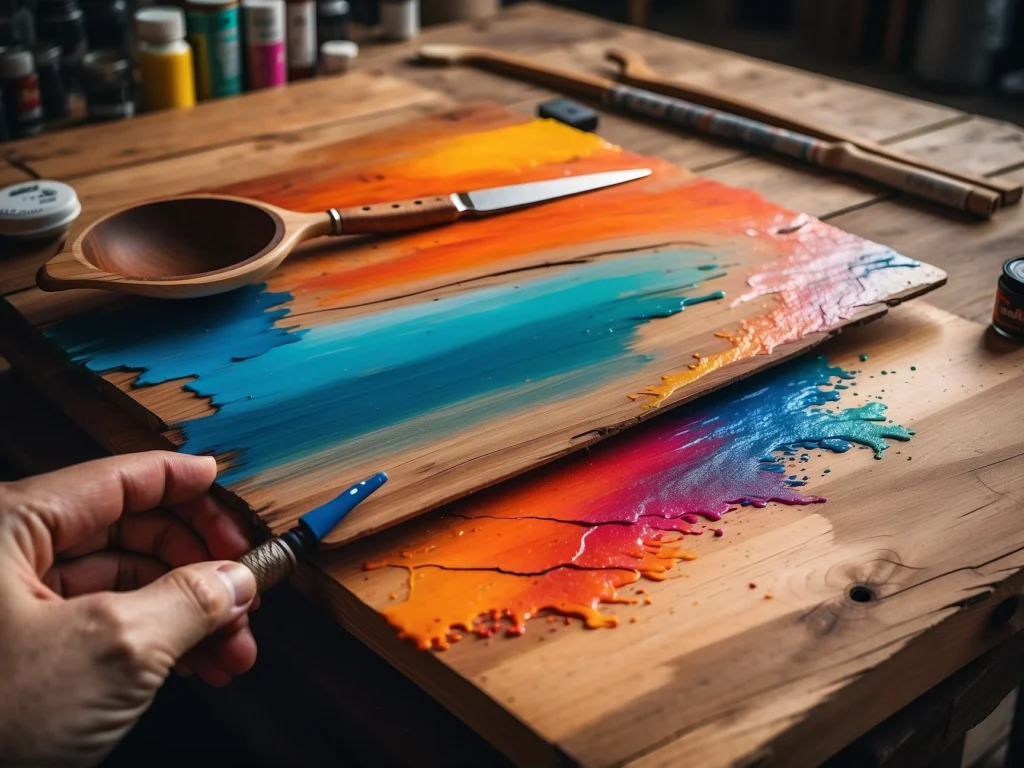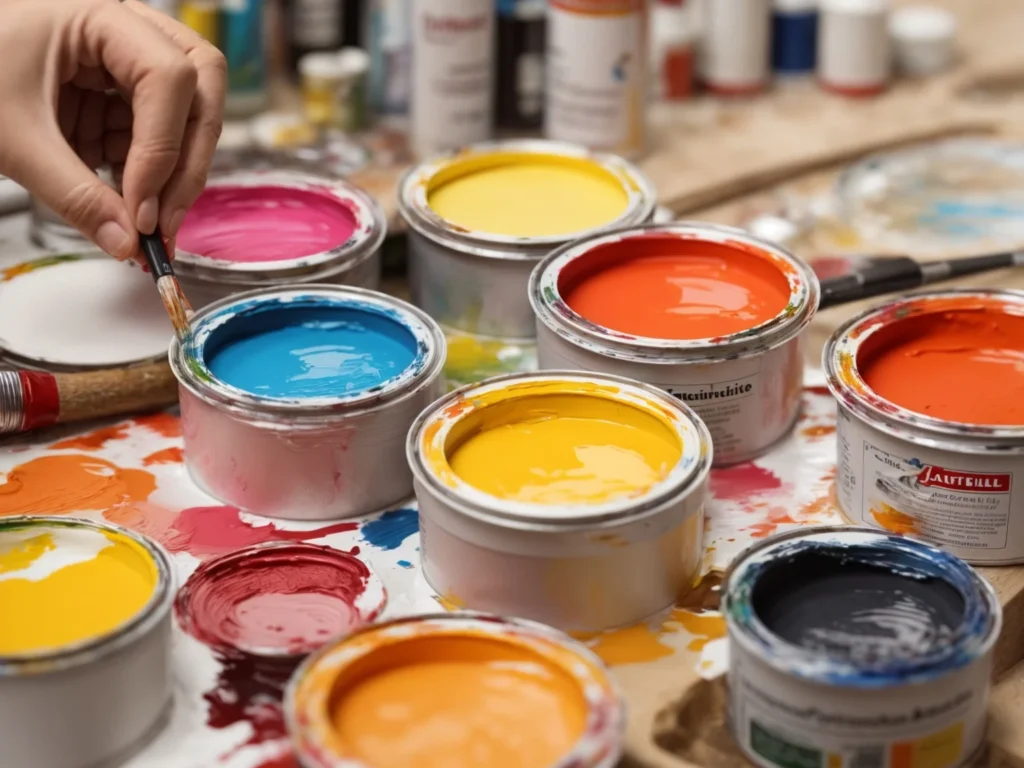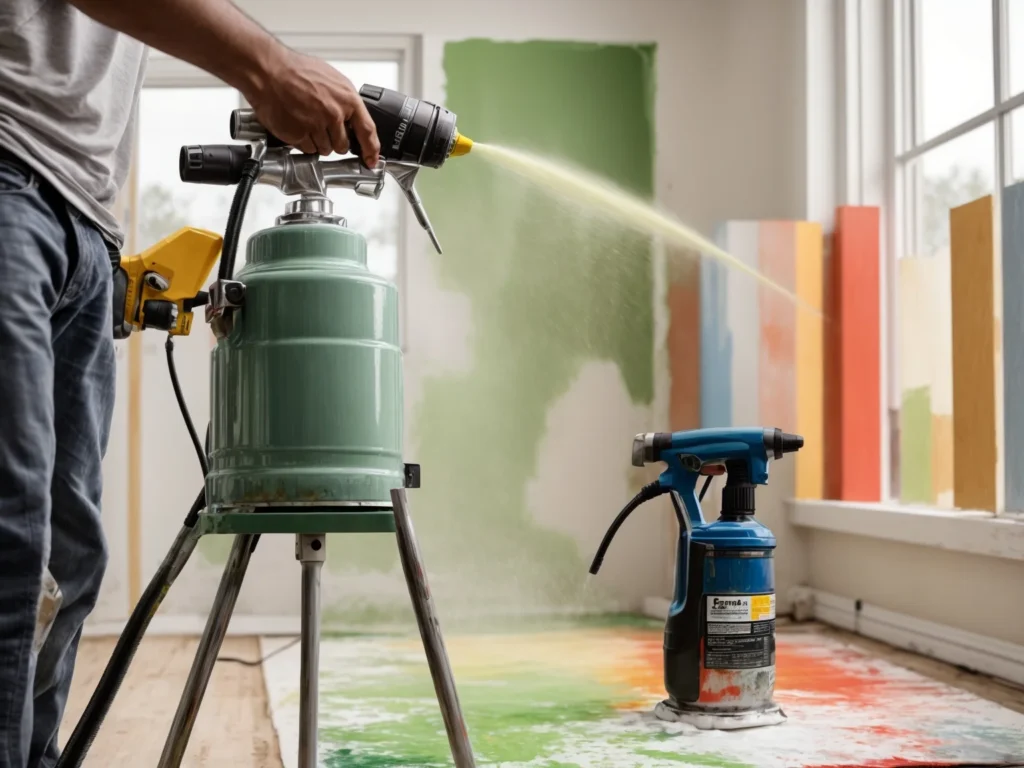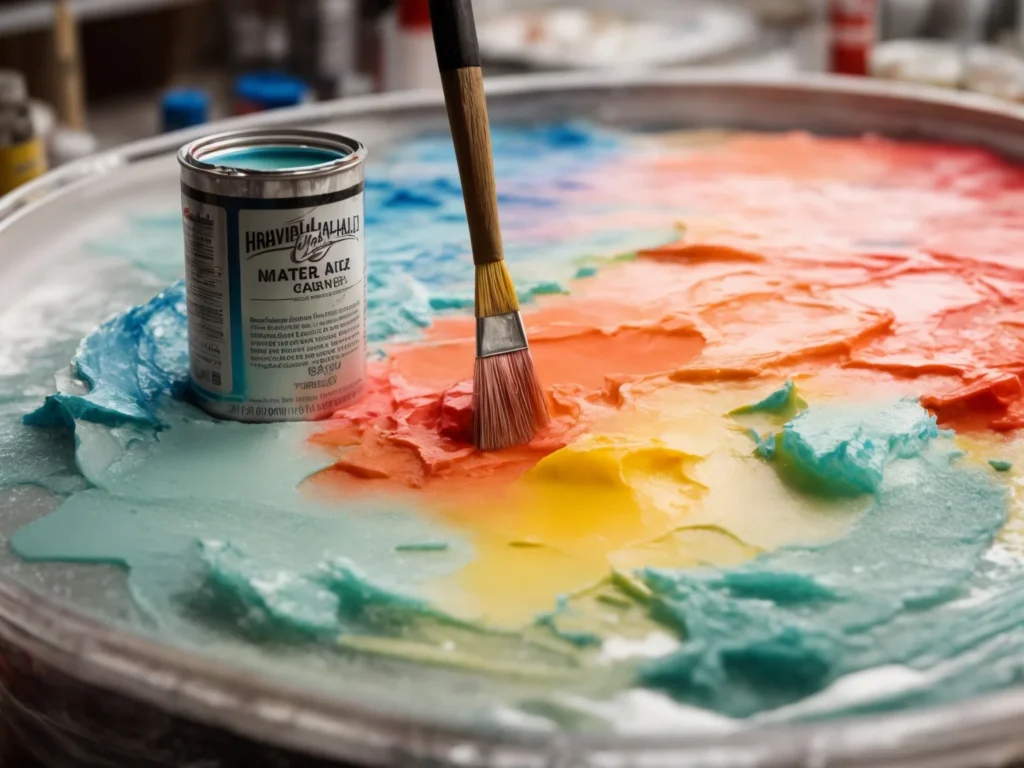Cement board, also known as cement backerboard, is a common building material used for walls and floors in bathrooms, kitchens, basements, and other areas prone to moisture. Made from a mixture of cement and fiberglass mesh, cement board is highly durable, fire resistant, and waterproof.
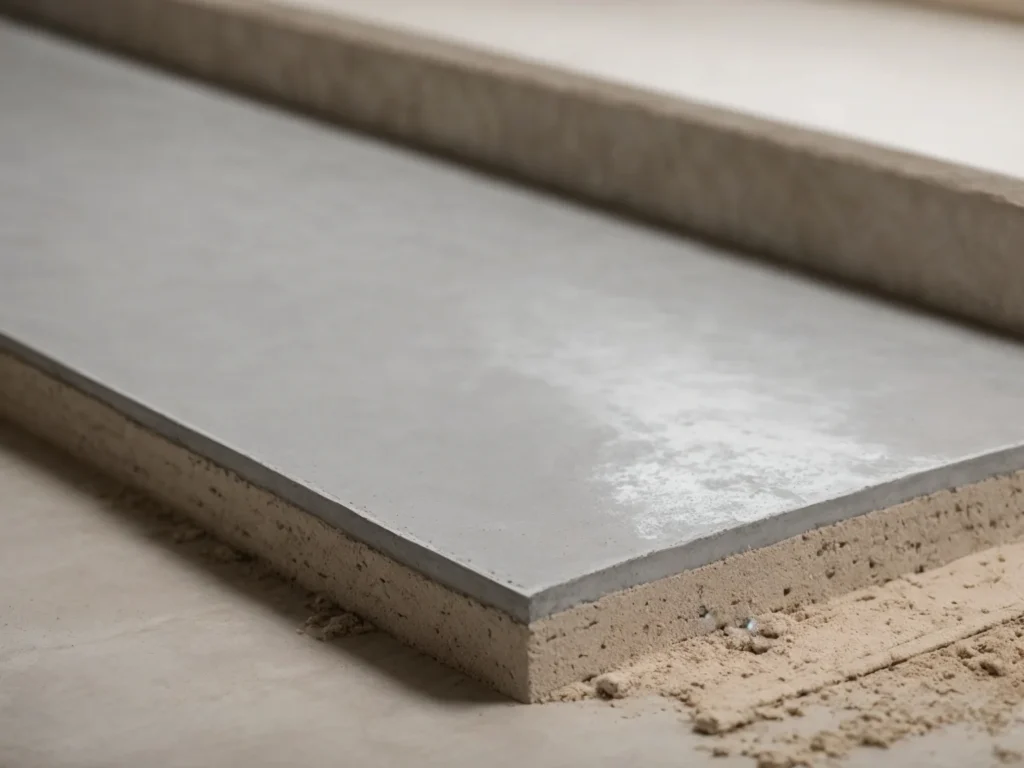
Unlike drywall, cement board can withstand prolonged exposure to water without warping or disintegrating. This makes it an ideal substrate for tile, especially in showers and tub surrounds. But cement board also requires some special considerations when it comes time to paint.
Can You Paint Cement Board?
The short answer is yes, you can paint cement board. When left unfinished, cement board has a rough, porous texture and drab gray appearance. Applying a few coats of paint is an easy and cost-effective way to give cement board a more polished, finished look.
Painting transforms rough cement board into a surface indistinguishable from drywall. It allows you to match the rest of the room’s wall color without the expense of tile, faux finishes, or other special treatments.
Almost any high-quality acrylic or latex paint will adhere well to cement board when proper preparation steps are taken. The key is using paints and primers specifically formulated for masonry and concrete surfaces. These coatings are engineered to flex and grip textured, alkaline substrates.
With the right prep work and paint products, you can achieve beautiful, lasting results painting over cement board. Properly painted cement board will resist moisture, mildew, and everyday wear and tear for years of worry-free performance.
Prep Steps for Painting Cement Board
While cement board can be painted, it does require some special preparation compared to drywall or wood. The natural texture and porosity of the cementitious surface must be addressed to ensure proper paint adhesion.
Follow these important steps to prep cement board siding and panels for painting:
Clean Surface
Wipe down cement board with a clean, damp cloth to remove dirt, dust, oil, and other surface contaminants. Let the surface dry completely.
Sand Surface
Lightly sanding smooths the surface texture so paint can adhere evenly. Use 120-150 grit sandpaper to knock down high spots and ridges. Avoid aggressively sanding, which can damage the cement board fiberglass mesh.
Fill Holes and Joints
Fill all seams, fastener indentations, and damaged spots with a cement board specific patching compound. Acrylic or silicone fillers made for concrete repair work well. Allow patching materials to fully cure before sanding flush.
Prime the Surface
Priming is a must before painting bare cement board. Quality concrete primers work to seal porous areas and provide extra grip for the topcoat of paint. Look for primer labeled for masonry and cement board like Zinsser Concrete and Masonry Bonding Primer.
Priming bare cement board helps paint adhere evenly and prevents premature peeling or chipping. It also allows for better coverage from the topcoat of paint.
Once prepped properly, cement board accepts most types of interior or exterior house paints.
Best Type of Paint for Cement Board
The best paint for coating primed cement board is 100% acrylic or acrylic-latex house paint. Acrylic paints offer superb adhesion, protection, and weather-resistance on exterior cement board siding and interior backerboard panels.
Here are the top paint options for achieving professional quality results on cement board:
- Exterior acrylic latex for outdoor cement board – Formulated to withstand sun, rain, and temperature extremes. Offer excellent adhesion and durability.
- Interior acrylic latex for indoor cement board – Provide a durable and scrubbable painted finish. Resist moisture and everyday wear and tear.
- Mold/mildew resistant bathroom paint – Special formulations for high humidity areas like showers and laundry rooms.
- High heat paint – For painting cement board around stoves and fireplaces. Rated for temperatures up to 800°F.
- Epoxy paint – Two-part coatings offer extremely durable and protective finish. Great for garages, basements, and laundry rooms.
For best results, always choose top-quality paints from reputable brands such as Behr, Sherwin-Williams, Benjamin Moore, or Valspar. Avoid cheaper paints that contain fillers or vinyl additives.
Oil-based alkyds, enamel, or porch and floor paint should also be avoided. The reduced flexibility of these coatings leads to premature cracking and peeling on rigid cement board.
| Type of Paint | Best Uses | Brand Recommendations |
| Acrylic Latex Exterior | Outdoor siding, trims, accents | Behr Premium Plus Ultra, Sherwin-Williams Resilience, Benjamin Moore Ultra Spec |
| Acrylic Latex Interior | Indoor walls, ceilings, accents | Behr Premium Plus, Sherwin-Williams Cashmere, Benjamin Moore Regal |
| Mold/Mildew Resistant | Bathrooms, basements, wet areas | KILZ Premium, Zinsser Perma-White, Behr Premium Plus Ultra |
| High Heat Paint | Fireplaces, behind stove | Rust-Oleum High Heat, INSL-X Stove & BBQ, Krylon High Heat |
| Epoxy Paint | Floors, laundry, garage | Rust-Oleum EpoxyShield, KILZ Floor, INSL-X Tough Shield |
Painting Cement Board Showers and Bathrooms
Cement board is the preferred backer material for shower walls, tub surrounds, and other wet rooms. To achieve a finished look in the bathroom, properly painting over cement board is key.
Special considerations for painting cement board in bathrooms:
- Use mold and mildew resistant bathroom paints rated for high humidity areas
- Ensure adequate ventilation when prepping surfaces and during drying time
- Apply waterproofing paint or sealer on shower walls before painting
- Avoid flat sheens which show water splatters and can mildew
- Clean with mild soap and water to maintain the paint against moisture and grime
Top quality bathroom paints like Behr Premium Plus Ultra offer lasting protection and easy cleanability between tile rows, on ceilings, and areas unsuited for tile.
For even greater water protection, applying a dedicated shower paint or sealer to cement board before painting is a smart idea. Products like RedGard Waterproofing or AquaDefense will waterproof the underlying cement board. Finish painting as desired with a mold resistant semi-gloss or satin bathroom paint.
Painting Cement Board for Wet Areas
Anywhere moisture is present, special care should be used when painting cement board walls and ceilings. Kitchens, laundries, and basements all benefit from mold and mildew resistant paints.
For showers and surrounds, apply a dedicated waterproofing sealer to the cement board prior to painting. RedGard, AquaDefense, and Drylok Fast Plug are top options.
Use semi-gloss or satin finishes in heavy moisture areas. Flat paints will absorb water splashes more and are prone to mildew growth. Satin or semi-gloss paints allow for easy wipe down and cleaning.
Proper ventilation during prep, painting, and drying is extremely important in wet areas. Running exhaust fans, opening windows, and using dehumidifiers helps moisture dissipate.
Painting Cement Board for Fireplace Surrounds
Cement board is an excellent non-combustible material for constructing fireplace surrounds and installing wood stoves. High heat paint allows applying color while withstanding intense temperatures.
For the surround, use high heat spray paint rated for 1000°F/538°C. Apply thin coats following all manufacturer instructions. Avoid spraying near open flames.
Paint cement board behind a wood stove or fireplace with dedicated stove paint for temperatures up to 1200°F. Brands like Stove Bright, Rutland, and Forrest offer durable flat black finishes perfect for radiant heat zones.
Allow all high heat paints to fully cure before firing up the stove or building the first fire. Avoid touching up with regular paints which will burn off with exposure to extreme heat.
Using proper high temperature coatings allows cement board fireplace surrounds and stoves to match any décor while protected from burning and smoke stains.
How to Paint Cement Board Siding
Painting exterior cement board siding helps structures withstand the elements while adding aesthetic curb appeal. Use 100% acrylic latex exterior house paint matched to your color scheme.
Follow these tips when painting outdoor cement board:
- Prep surface by pressure washing and sanding to improve adhesion
- Fill any cracks or damaged areas with exterior spackling compound
- Prime cement board with masonry primer before painting
- Only apply paint in dry weather when temperatures are above 50°F
- Use brush, roller, or airless sprayer for full, even coverage on textured siding
- Plan for 2-3 coats of quality acrylic latex exterior paint depending on color
- Allow proper drying time between coats as specified by manufacturer
- Apply every 5 years to refresh appearance and weatherproofing
Proper prep work is key to achieving long lasting results painting exterior cement board siding and trim boards. Always use exterior-rated primers and paints formulated for concrete and masonry.
Painting Cement Board to Look Like Drywall
Sometimes you may need to blend cement board areas to match surrounding drywall. Often seen on bathroom walls or mixed material surfaces, this is achieved with a simple skim coat finish.
To make textured cement board look like smooth finished drywall:
- Sand rough areas of cement board with 120-150 grit sandpaper
- Mix drywall joint compound per directions and “skim coat” over the entire surface, filling pores and smoothing texture
- Allow skim coat to fully dry overnight
- Lightly sand skim coat layer to smooth and remove any high spots
- Apply drywall primer such as Zinsser Bulls Eye 123 to entire surface
- Paint with desired sheen interior acrylic latex paint to match drywall finish
The skim coat fills in the natural texture of cement board to create a flat, smooth surface indistinguishable from drywall once primed and painted. This is a budget-friendly way to finish mixed material walls.
Tips for Successfully Painting Cement Board
Follow these best practices when painting interior or exterior cement board surfaces:
- Always prime before painting – Priming seals the porous concrete material and allows for much smoother topcoat application.
- Use quality brushes and roller sleeves – Look for soft nylon/polyester blends designed for smooth coatings. Avoid stiff bristle brushes.
- Thin coats are better – Apply paint in multiple thin, even layers rather than thick heavy coats which can sag or run.
- Allow proper dry times – Rushing between coats can ruin paint job. Follow manufacturer’s instructions for drying between coats.
- Ventilate areas well – Ensure adequate air circulation to let moisture dissipate, especially in bathrooms.
- Caulk gaps before painting – Fill any cracks or damaged seam areas with flexible caulk rated for exterior or interior use.
Proper prep work and using the right paint products will result in cement board that looks professionally finished. Patience leads to painting success.
Painting Cement Board VS Other Common Surfaces
Painting cement board does require some different approaches than coating drywall or wood surfaces in your home. Here’s how cement board compares:
Painting Cement Board VS Drywall
- Cement board requires heavy sanding/prep work – Drywall usually only needs quick sanding of mudded areas
- Cement board must be primed before painting – Self-priming paints can sometimes be used directly on drywall
- Texture remains visible through paint on cement board – Drywall mudding creates smooth surface
- Cement board paint needs abrasion resistance – Bathroom drywall needs moisture resistance
- Skim coat required to match drywall texture – No alteration needed to achieve flat drywall look
Painting Cement Board VS Wood
- Cement board doesn’t require grain filling – Wood often needs porous grain filled for smooth finish
- Cement board painting needs masonry primers – Wood usually coated with dedicated wood primer
- Acrylic paints stick well to cement board – Oil-based paints often used on wood trim
- No worry about tannin bleeding with cement board – Knots and water stains can bleed through wood paint
- Cement board paint build up is thin – Wood can support thicker paint film builds
The differences mean taking a tailored approach to achieve the best painted finish on cement board surfaces.
Painted Cement Board Adds Style at a Fraction of the Cost
Painting over unfinished cement board is an easy and cost-effective way to add personality to your space. By prepping properly and using the right paints, you can achieve beautiful results.
Painted cement board provides a polished finished look for a fraction of the cost of tile, textured wall treatments, or other special finishes. Just be sure to use top quality acrylic paints and primers specifically engineered for masonry and concrete surfaces.
